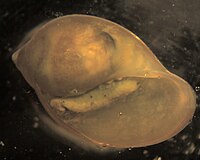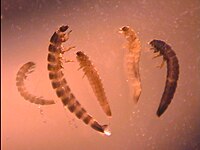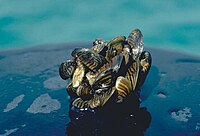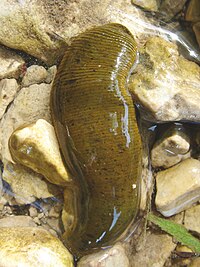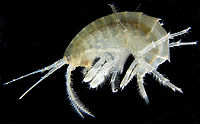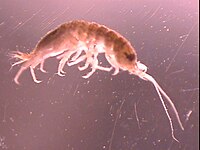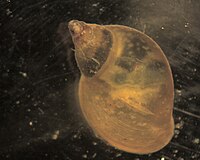Vermont EPSCoR's Streams Project; A Teacher Collaboration on WikiEducator
Openly shared content, practices, and developing resources from Vermont EPSCoR's Streams Project. Join this collaboration and make a difference!
 ECHO waterfront |
|---|
|
| Basin: | Lake Champlain |
| State or Province: | Vermont |
| Country: | USA |
| Latitude: | 44.475983 |
| Longitude: | -73.221775 |
Congrats, you have created a new stream page. To delete this line, add more invertebrates, and see hidden instructions just hit edit above.
The following are the most common invertebrates collected from this stream site.
Chironomidae
- Order
- Diptera
- Family
- Chironomidae
- Common name
- Nonbiting midge
- Tied fly
- Griffith's Gnat
Midge larvae tend to be the most common macroinvertebrate at our sites. As with other Diptera, there are no true jointed legs. Chironomidae do have a pair of prolegs at each end and preserved individuals tend to curl into a 'C'. Identification past family requires slide-mounted heads. We have seen philopotamid caddisflies misidentified with the chironomids and we suspect that that happens when samples are being sorted from trays. Under a microscope, six prominent legs can be seen on members of the caddisfly family Philopotamidae.
More information on Philopotamidae.
Physidae
Members of the family Physidae belong in the class of Gastropoda. Members contain a single, coiled shell with a left handed spiral going counterclockwise. Belonging to the family of aquatic pulmonates, members breathe air using a structure similar to a lung.
Images of the family Physidae, the class of Gastropodaand a shell with a left-handed spiral.
Elmidae
- Order
- Coleoptera
- Family
- Elmidae
- Common name
- riffle beetle
We very commonly find adult and larval riffle beetles. The adults are clearly beetles, but the larvae can be confused with other orders. The forward pointing tooth on the front end of the larvae as described in the key can be a challenge to see, particularly in small individuals. Larvae are characterized by having a single tarsal claw at the end of their legs, which have 4 segments. Adults, on the other hand, have two tarsal claws at the end of each leg. Commonly encountered genera include
Dubiraphia,
Macroychu,
Optioservus,
Phanocerus,
Promoresia, and
Stenelmis.
Images of the adult and larval riffle beetles.
More information on Dubiraphia, Macronychus, Optioservus, Phanocerus, Promoresia, and Stenelmis.
Dreissena polymorpha
- Order
- Veneroida
- Family
- Dreisseniidae
- Genus
- Dreissena
- Common name
- Zebra mussel
Because zebra mussels are invasive exotic species, it is important to ensure that they are not inadvertently moved to other water bodies. Follow the most current DEC guidelines on safe practices when dealing with invasive species. The guidelines currently (last checked Nov 2009) include drying equipment for at least 5 days prior to using elsewhere.
Hirudinea
Leeches have bodies with 20 or more segments and a ventral suction disk on at least one end, though sometimes on both ends. They are segmented worms (Phylum Annelida) in the Class Hirudinea. Most of the leeches we sample come from ponds and lakes but they are also commonly found in streams.
Image of the ventral suction disk.
Gammaridae
- Order
- Amphipoda
- Family
- Gammaridae
The body of this scud is flattened side-to-side. It has seven pairs of walking legs and two pairs of antennae. On third third antennal segment, there is a segmented flagellum.
Images of the body flattened side-to-side, and the segmented flagellum.
Lirceus
- Order
- Isopoda
- Family
- Asellidae
- Genus
- Lirceus
These aquatic invertebrates are also known as sowbugs. They are flattened top to bottom.
Be sure not to confuse them with the terrestrial sowbugs that can, on occasion, end up in aquatic samples. Terrestrial species have both shorter antennae and legs.
Lymnaeidae
Members of the family Lymnaeidae belong in the class of Gastropoda. Members contain a single, coiled shell with a right-handed spiral. Differing from those of Planorbidae, members of Lymnaeidae have a larger opening. Respiration in these snails are through lung-like structures. Preferred habitats include those with slow streaming waters and heavy vegetation. These right handed snails are somewhat less tolerant of water pollution than our other common snails.
Images of the family Lymnaeidae and the class Gastropoda.


